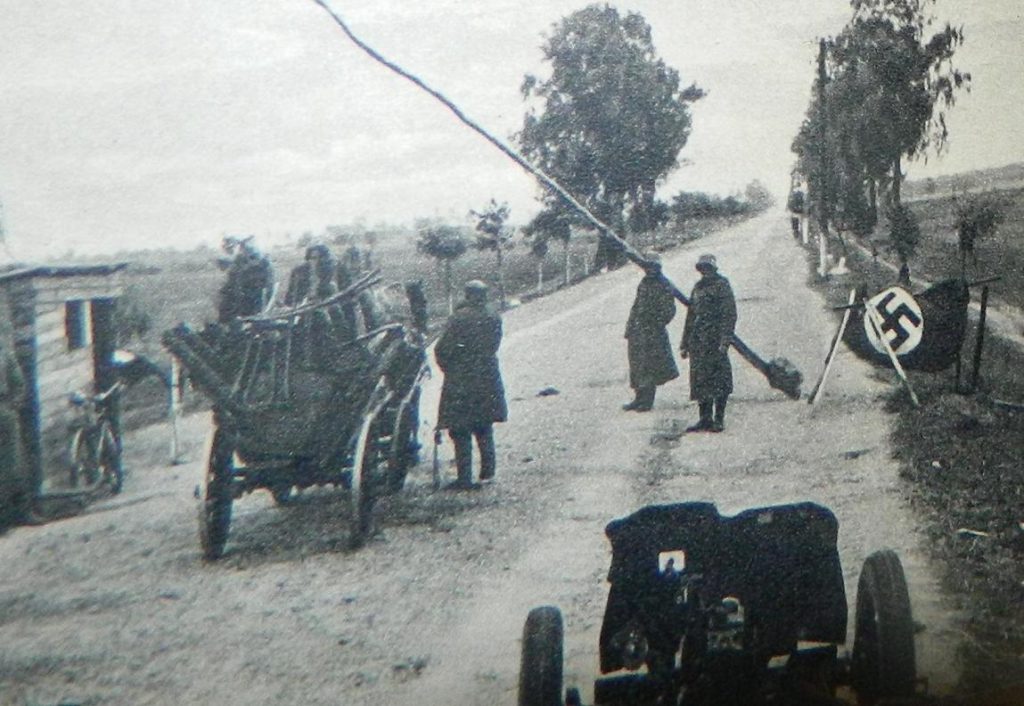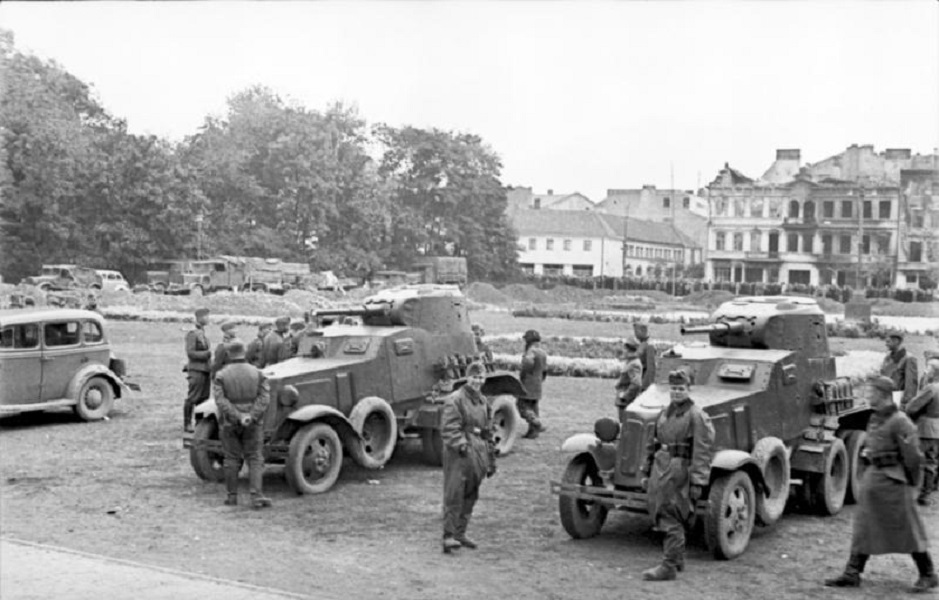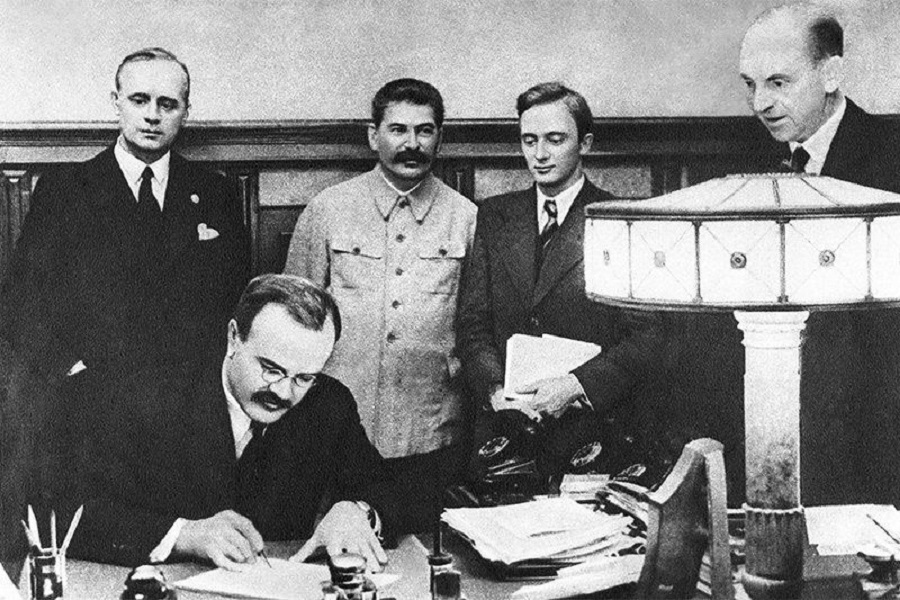On 23 August 1939, Nazi Germany’s foreign minister Joachim von Ribbentrop and his Soviet counterpart, Vyacheslav Molotov, signed a non-aggression treaty – the Molotov–Ribbentrop Pact – along with secret protocols carving up Eastern Europe between the two totalitarian powers. Meelis Maripuu reflects on a deal whose consequences haunted Estonia until 1991.*
In the second half of the 1930s, two totalitarian regimes emerged as new key figures on the European political scene, both of which were feverishly preparing to expand their powers.
Adolph Hitler’s Nazi Germany had gotten a head start on Joseph Stalin’s Communist Soviet Union (USSR) – in 1938 and 1939, Germany had already annexed Austria and part of Czechoslovakia. Stalin had not yet been able to play a decisive role in major international politics, but the plans for a communist world revolution had not been abandoned and were awaiting implementation.
In 1939, Stalin became the decisive factor when it came to determining the fate of the European war. On one side stood Germany, and on the other side Britain and France, who, as major powers, guaranteed the independence of several smaller European countries through aid agreements.
In the summer of 1939, the focus was on Poland, to which Germany had made a series of territorial claims. The British and French guarantee to Poland initially held Germany back because Hitler was not ready to face a war on two fronts. The accession of the USSR to the guarantee to Poland might have put an end to Hitler’s subsequent conquests in theory, but Poland itself was categorically opposed to the USSR’s guarantee. They were justifiably afraid that the Soviet Red Army, after coming to help them in a war situation, would no longer leave the country and Poland would inevitably be sovietised.
Since the spring of 1939, the USSR had essentially been conducting negotiations with the UK and France on the one hand and Germany on the other, exploring the possibilities of a more beneficial agreement. Stalin’s goal was to buy as much time as possible before his own intervention in the war and to seek an agreement with the supported party on the most favourable terms. Stalin’s focus was on the entire region from the Gulf of Finland to the Black Sea. He suddenly broke off talks with Britain and France on 21 August, after receiving confirmation of a better offer from Hitler. What happened next, happened very quickly.
Nazi Germany and the Soviet Union make a deal
On 23 August, the German foreign minister, Joachim von Ribbentrop, and Vyacheslav Molotov, the People’s Commissar for Foreign Affairs of the USSR, arrived in Moscow to sign an international non-aggression treaty (the so-called Molotov-Ribbentrop Pact) and its additional secret protocols.
The public part of the treaty obliged the parties to refrain from aggression against each other and any unions or agreements against the other party. The secret additional protocols of the treaty divided the spheres of influence in Eastern Europe: the Baltic states (Finland, Estonia and Latvia) and Bessarabia, which belonged to Romania, were considered to be in the Soviet sphere of influence. Poland was divided between the parties and Lithuania was initially left to Germany.

However, the Soviet-German Treaty of Amity and Cooperation, signed on 28 September, after the occupation of Poland, was an amendment to previous agreements and completed the fourth division of Poland. With the new additional secret protocol, Lithuania was added to the USSR’s sphere of influence and Germany was given the Lubin region in Poland.
The agreement of 23 August allowed Hitler to launch an invasion of Poland on 1 September, which is regarded as the start of World War II. However, Stalin did not begin his invasion of eastern Poland until 17 September, waiting for a reaction from the West and leaving Hitler as a symbolic sole culprit in the war. On 28 September, a joint military parade was held in Brest-Litovsk to celebrate the victory over Poland by the German-Soviet Alliance.

Imposing Soviet military bases in Estonia
At the same time, the USSR, under the secret protocol, imposed mutual assistance agreements (the so-called bases’ agreements) on the Baltic states, which allowed it to establish military bases in the border states, Estonia among them. Finland refused the establishment of bases, which led to the Winter War initiated by the USSR. As a result of the war, Finland lost a number of regions in the east of the country and had to accept the establishment of Red Army bases on the Gulf of Finland, but retained its national independence.
In June 1940, as the rest of the world watched Hitler’s triumph in Paris, the Soviet Union occupied and annexed the Baltic states. In the occupied areas, mass repression and the sovietisation of society immediately began.

In the short term, the strong annexation of its sphere of interest weakened the strategic positions of the USSR. The conquered areas were economically more advanced than the territory of the USSR and were home to 20 million people who were not very Soviet-friendly. The construction of new lines of defence was not completed before the outbreak of the war and the Soviet Union was in a very vulnerable state when the Germans attacked in the summer of 1941.
In the long run, however, Stalin succeeded. The USSR bore the brunt of the fight against Hitler, but at the same time, the Western allies had to de facto recognise not only the border of the USSR as at 1941, but its new sphere of influence in Central and Eastern Europe, where a wave of sovietisation was soon unleashed.
The Molotov-Ribbentrop Pact effect lasted until 1991
The Molotov-Ribbentrip Pact became invalid on 22 June 1941, when Germany attacked the USSR. The secret protocol of the pact was unlawful from its signing and in May 1945, one of the parties to the treaty, Hitler’s Germany, terminated its existence. With its support, two supremacist totalitarian regimes had plunged much of western society into war and killed tens of millions of people.
However, the spheres of influence agreed upon with this pact remained on the winning side for decades until the collapse of the USSR, because the realpolitik of the other countries was unable or unwilling to change this. However, the USSR’s annexation of the Baltic states was not de jure recognised by the Western powers, which, in many ways, facilitated the process of regaining independence in 1991.
The USSR denied the existence of the secret protocols until 1989, when the USSR People’s Deputies Congress declared the pact and its secret annexes null and void. However, the effects of the Molotov-Ribbentrop Pact were only finally eliminated with the departure of former Soviet Army units from the Baltic states and other parts of Eastern Europe, which lasted for years.
* This article was originally published on 21 August 2019.


Thank you for this summary. The free West did not include this important information in their texts, teaching or media until encouraged or forced to in the wake of the information avalance of the nineties, over half a century after it happened. Yet even today the poisonous significance of Marxist-inspired mass manipulation and genocide is not fully feared or recognized, although the Chinese government still stands as a living and active engine of its suppression of human liberties. And our school systems here in America and Canada have overt influencers attempting to raise a new generation subservient to powerful corporate interests and inspired by a naive understanding of Marxist ideologies. We need to continously disseminate accurate historical information.